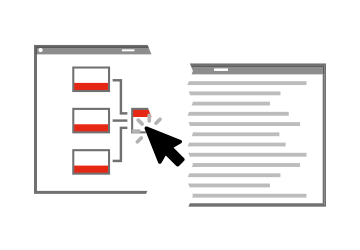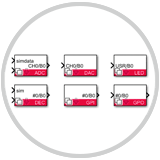

Imperix - Model B-BOX RCP 3.0 - Rapid Control Prototyping System
System on chip: Xilinx Zynq XC7Z030-3FBG676E
Digital outputs: 16x Electrical (3.3V/5.0V)
DSP / Processing cores: 2x ARM Cortex A9 1GHz; 1GB DDR3
Digital inputs: 16x Electrical (3.3V/5.0V)
FPGAs: Xilinx Kintex 7 125K (user programmable); Xilinx Artix 7 35T (auxiliary)
Fault inputs: 16x Electrical (3.3V); 1x Electrical interlock; 1x Optical interlock
Analog inputs: 16x 16bits @ 500ksps; Simultaneous sampling; Programmable full-differential front-end
Incremental decoder inputs: 4x 3-pins (A,B,Z); (shared with GPI inputs)
PWM outputs: 16x Optical; 32x Electrical (3.3V)
Communication: 1x CAN;1x Ethernet 1 Gbps; 3x SFP+ 5Gbps (RealSync)
User High-speed I/Os: 36x Electrical (3.3V)
The RCP controller target supports the implementation and real-time tuning of the most advanced digital control techniques for power converters. This requires not only excellent performance but also a high level of flexibility and ease of use.


The B-Box RCP prototyping controller can be programmed using C/C++, or simulation software such as Simulink or PLECS. Thanks to our fully-automated code generation toolchain, just one single click is needed to fully program the device!
The blocksets also embed simulation models so that the system can be accurately simulated and tuned before code is generated.

Absolutely no expertise in FPGA-based development is needed to work with the B-Box RCP. It operates readily with a very flexible and entirely configurable FPGA firmware.
Nevertheless, for the advanced users who require rapid control prototyping to involve custom FPGA code, the RCP target allows doing so. Dedicated FPGA areas are provided, with straightforward integration with DSP software.





The B-Box RCP uses a dual-core processor (Xilinx Zynq). One DSP core is dedicated to the real-time control tasks (bare metal, dedicated kernel), the other one to the system supervision and monitoring (Linux). Most low-level tasks are also shifted in FPGA.
This results in the full dedication of a fast floating-point processor (DSP) to power converter control purposes, with tremendous performance, ranging up to 400 kHz control frequencies in closed-loop operation.

In stacked configurations, all units are naturally synchronized with an accuracy of ±2 ns (!) thanks to imperix’s RealSync technology. This allows using all I/Os as if they simply belonged to the same controller hardware!





In case of inappropriate operation, the controller instantly blocks its PWM signals, thanks to dedicated hardware protection circuits. This guarantees excellent protection, entirely independently from both the DSP cores and the FPGA.
The B-Box RCP prototyping controller is also self-protected against inappropriate conditions such as excessive computational burden or algorithmic errors.

Each rapid prototyping controller possesses 16 fully configurable analog input channels. This obviates the need to repeatedly develop signal conditioning interfaces for every project. Each input channel features:
- 3k? differential voltage input or 100? single-ended current-type input.
- Programmable safety thresholds.
- Programmable gain amplifier and low-pass filter
